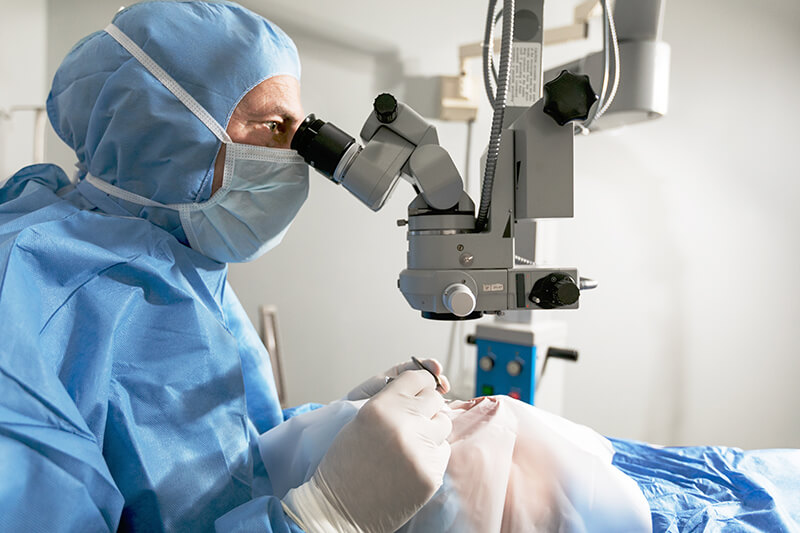حول الموضوع
اعتلال الشبكية السكري هو أحد مضاعفات مرض السكري غير المضبوط وارتفاع نسبة السكر في الدم بشكل مستمر على مدى عدة سنوات، مما يؤدي إلى حدوث مرض في شبكية العين يمكنه أن يؤثر على قدرتها على نقل الصور إلى الدماغ من خلال العصب البصري.
تلعب الأوعية الدموية الموجودة في الشبكية دوراً مهماً في تزويدها بالأكسجين والمواد المغذية، مما يحافظ على سلامتها وفعاليتها.
يمكن أن يؤدي اعتلال الشبكية السكري إلى تلف في الأوعية الدموية، والتي قد تتعرض للنزيف أو الارتشاح أو الانسداد، مما يؤدي إلى أذية الخلايا في شبكية العين بحدّ ذاتها.
هناك أشكال ومستويات مختلفة لاعتلال الشبكية السكري. فعلى سبيل المثال، عندما تتعرض شبكية العين للتلف، قد تنمو أوعية دموية جديدة فيها لدرجة انفجارها، مما يؤدي إلى نزيف وعدم وضوح الرؤية. في حال حدوث اعتلال البقعة السكري (البقعة هي المنطقة المركزية من شبكية العين)، يكون المرض قد بلغ مرحلة أكثر تطوراً وشدةً.
ويؤدي ترافق الإصابة بارتفاع ضغط الدم ومرض السكري إلى حالة أكثر خطورة.


أنواع اعتلال الشبكية السكري
- اعتلال الشبكية السكري غير التكاثري
بشكل عام، لا يؤثر هذا النوع من اعتلال الشبكية السكري على الرؤية، لأنه لا يكون هناك في المرحلة الأولية سوى عدد قليل من الأوعية الدموية المتضخمة، مع الحد الأدنى من النزيف والارتشاح في شبكية العين.
من شأن فحص شبكية العين من قِبل طبيب العيون أن يكشف بعض العلامات التي تشير إلى وجود هذه الحالة. - اعتلال الشبكية السكري التكاثري
يمكن أن تؤدي هذه الحالة إلى ضعف البصر بشكل خطير بسبب نمو الأوعية الدموية في شبكية العين والخطر المتمثل بنزيف هذه الأوعية مما قد يؤدي إلى تلف الشبكية، وحتى انفصالها عن الجزء الخلفي من العين. يعدّ العلاج بالليزر ضرورياً لتجنب حدوث تلف خطير طويل الأمد. - اعتلال البقعة السكري
يحدث اعتلال البقعة السكري عند ارتشاح الأوعية الدموية في المنطقة المركزية للشبكية، والتي يمكن أن تسبب تورم البقعة، مما يؤثر على مستوى الرؤية. خيارات العلاج الرئيسية هي عمليات الليزر أو الحقن أو الجراحة.
الأسباب
يعاني العديد من مرضى السكري، وخاصة أولئك الذين يكون لديهم المرض غير مضبوط بحيث يكون هناك ارتفاع في مستويات السكر في الدم لفترات طويلة، من وجود تلف في الأوعية الدموية في شبكية العين، والتي تعدّ النسيج الذي يبطّن الجزء الخلفي من العين ويكشف الضوء ويسمح لنا بالرؤية. يؤدي ذلك إلى الإصابة بمرض يسمى اعتلال الشبكية السكري، والذي يصيب 8 من كل 10 مرضى مصابين بداء السكري لمدة 10 سنوات أو أكثر.
الأعراض
- بقع أو خطوط عاتمة تظهر في مجال الرؤية (الأجسام العائمة)
- عدم وضوح الرؤية.
- رؤية غير ثابتة.
- اختلال رؤية الألوان.
- مناطق عاتمة أو فارغة في مجال الرؤية.
- فقدان البصر.
تتوفر خيارات علاجية مختلفة، وأحياناً يتم استخدام مجموعة من عدة علاجات متاحة. وتشمل هذه العلاجات حقن الأدوية داخل الجسم الزجاجي (أدوية مضادة لعامل النمو البطاني الوعائي و / أو الستيرويدات)، والليزر المحيطي التقليدي، والليزر المجهري منخفض الشدة. في الحالات الأكثر شدة التي يحدث فيه اعتلال الشبكية التكاثري أو النزيف داخل الجسم الزجاجي، قد تكون الجراحة هي الخيار الوحيد المتاح.
يؤدي التشخيص المبكر لمضاعفات مرض السكري عموماً إلى تحسين تدبيرها ونتائجها، ولهذا السبب من المهم جداً إجراء فحوصات منتظمة للعين.
اطلب موعد








